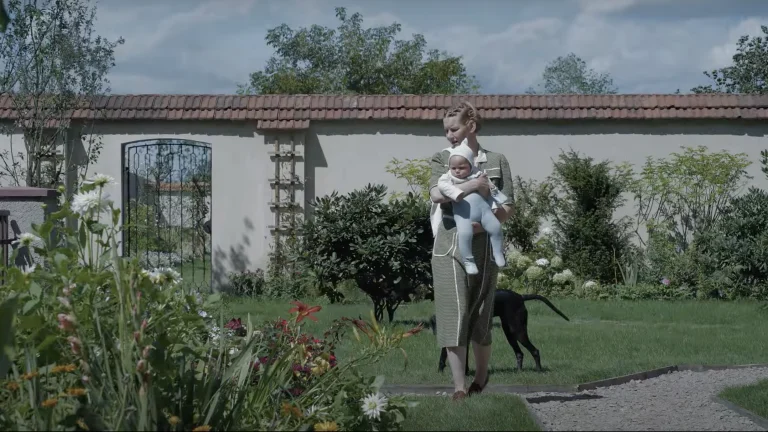“Predator: Badlands,” directed by Dan Trachtenberg, is an elegy for outcasts that explores the cohesive aspects of grief, which makes radical solidarities possible among xenolifeforms and artificially intelligent machines (or “synthetics”). The eugenicist world of the Yautja resembles the world of Zack Snyder’s rendition of ancient Greece in “300” (2006), where deformed and physically weak newborns are ritually tossed to death for the ‘greater good of Sparta.’ ‘The greater good of Sparta’ is a euphemism for its healthy reproductive future, devoid of frail bodies that are unsuitable to reproduce and enlist in the army. Unlike “300,” “Predator: Badlands” does not celebrate but undermines the logic of eugenics by temporarily ameliorating hierarchical oppression on Yautja Prime, the home planet.
“Predator: Badlands” explores the theme of Predator-on-Predator violence, which drives the central unfolding plot, traversing light-years and set on two xenoplanets: Yautja Prime and Genna. This is the second time viewers have witnessed Predator-on-Predator violence. It first appeared in “The Predator” (2018, directed by Shane Black), set on Halloween night, when the Yautja sends their genetically modified Ultimate Predator to hunt down the rogue Predator, retrieve the contraband known as the Predator Killer, and collect Captain McKenna’s autistic son as a trophy. “The Predator” also used a contesting term, “sport hunter,” to define the Yautja, as “Predator” literally means a creature that needs to kill its prey for survival, which is never the case for the Yautja.
In “Predator: Badlands,” tradition meets an upgraded individual talent, and undoing dogmas on Yautja Prime assumes the form of radical solidarities among a Yautja, a regenerative xenolifeform, and an AI synth. But why would a Yautja need to forge such radical solidarities? The answer is simple. The Yautja never encountered a planet like Genna where their weapons and “tools” of dominance would become obsolete in the face of xenoplanetary technologies, i.e., technologies of self-preservation and defense mechanisms built into all that is born and grows on Genna. The xenoplanetary technologies found in Genna’s flora and fauna aggressively resist Yautja’s encroachment on its environment. Genna is unlike planet Earth, a technologically rudimentary “backwater planet” where humans worshipped Yautja as gods who taught them to build civilization.
This origin story appears in “AVP: Alien vs Predator” (dir. Paul Anderson, 2004). Genna’s unwelcoming nature is well known to Yautja, who call it the “Dead Planet.” Now, how can a xenoplanet teeming with such complex flora and fauna be dead? It is dead to the Yautja because it cannot support them. Therefore, a Yautja can survive on Genna only through its radical solidarity with other beings. Genna is like Planet 4 in Ridley Scott’s “Alien: Covenant” (2017), which is beyond human containment because it does not support non-botanical lifeforms, or anything composed of meat, due to the presence of neomorphs and hybrids.
In Genna, the predator becomes the prey. This change of fortune is in tandem with Dan Trachtenberg’s consistent theme, previously explored in “Prey” (2022)—where a Yautja becomes a prey of its prey, a Comanche warrior named Naru—and the animated “Predator: Killer of Killers” (2025)—a three-part story set in various centuries, involving three unique Yautja coming face to face with a Viking, a Samurai, and an American aviator.
The most fascinating aspect of radical solidarity on Genna is the bridging of xenolanguages through Thia the synth’s translation feature, which allows it to simultaneously communicate with the Yautja in its language (appearing in the subtitles) and with viewers in English. The synth breaks the fourth wall by becoming aware of the audience’s presence. Dan Trachtenberg has previously explored language barriers and human solidarity in “Predator: Killer of Killers” (2025). In recent years, we too have seen the breaking of this fourth wall in “Fleabag” (2016) and the “Deadpool” movies, where fictional characters, aware of the audience’s presence, verbally or gesturally communicate with them without necessarily acknowledging their own fictional nature!

Predator: Badlands’s depiction of a synth that translates multiple languages in real time and breaks the fourth wall comes in a year when Apple introduces its AirPods with a live translation feature, and during a period of politically myopic restructuring of higher education institutions that threatens language studies programs and departments throughout the United States with possible discontinuation. “Predator: Badlands” is very much a product of prevailing US politics as much as of posthumanist philosophy, given that this is the first “Predator” movie in the franchise to be devoid of human characters. The absence of humans always complicates things, as we figure out that whatever is true for humans is also true for other extraterrestrial beings, at least in the realm of fiction.
The Yautja’s extended solidarity on Genna challenges the existing sacrality of Yautja codes. In the movie, Yautja, being generational hunter-warriors, have an ambiguous attitude toward friendship. Friendship—a more enhanced form of radical solidarity—is a paradoxical creed in the Yautja’s conflictual, competitive lifestyle. Friendship fosters sentiments such as sympathy, compassion, and a sense of care for others. Yautja hunt alone and are supposed to fend for themselves, and friendship acknowledges a reliance on others for reflections, strategies, protection, and self-preservation.
A Yautja that relies on others or has a friend or ally for its survival is considered weak on Yautja Prime. This attitude adheres to the Yautja Codex, which reminds the audience at the beginning of the movie: “Yautja are prey to none. Friend to none. Predator to all.” But there is a rub here. “Friends to none” in the Codex can be interpreted in two ways. Either the Yautja are friends to none in the entire galaxy, including other xenospecies or beings, in which case the movie subverts this tenet, or if the Yautja tenet is specific to Yautja Prime, then a Yautja cannot befriend other Yautja, in which case befriending humans, synths, or other apex creatures outside the Yautja race is not prohibited by Yautja law since the Codex does not explicitly mention it.
The tenet’s vagueness expands the scope of the law, allowing the movie to experiment with radical solidarities on a xenoplanet. Besides “Predator: Badlands,” the last time we saw a Yautja forge a bond with another xenospecies was in “AVP,” when the Yautja marked and befriended the Antarctic mission guide, Lex, who saved his life and helped him fight the Xenomorph Queen. Yautja marking their own bodies with the bodily fluid/blood of their enemies is an essential rite of passage, as already mentioned in “AVP.” Thus, when Yautja mark others with their own or the common enemy’s fluid/blood, it qualifies as a bond of solidarity.
Playing with radical solidarities, Dan Trachtenberg has introduced a new apex predator in the “Predator” movie franchise, which is in tandem with Noah Hawley’s introduction of a new apex predator called Ocellus—the parasitic tentacular eye—in “Alien: Earth” (2025), which has enough audacity and power to rival the xenomorph. Moving ahead, I anticipate that Dan Trachtenberg’s vision of radical solidarities will shape the future of the “Predator” franchise, which will eventually bleed into a possible third epic crossover with the “Alien” franchise. The crossover will intensify the idea of radical solidarities, as “Alien: Earth” features Wendy, a human-synthetic character sympathetic toward the xenomorphs, while “Predator: Badlands” presents an AI synthetic that is compassionate toward a Yautja.






